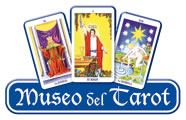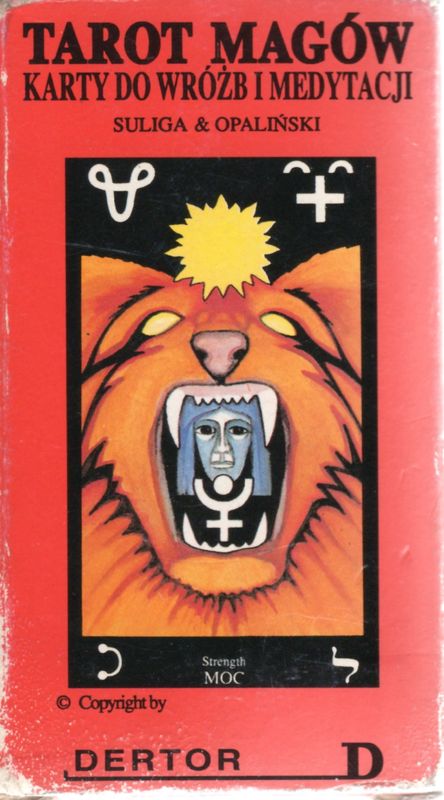Entre los países de Europa del Este, Polonia "lidera el grupo" como productor de tarots fascinantes y originales. Una de las primeras barajas polacas de 78 cartas fue el célebre Tarot Magow. Atractivamente colorido y lleno de un profundo simbolismo hermético, el Magow llamó la atención de una audiencia mundial más amplia cuando K. Frank Jensen lo documentó en su célebre publicación, Manteia. En el número 7, pág. 29, Jensen escribe: "Si bien muchas barajas de tarot modernas se han alejado de los contenidos herméticos / esotéricos hacia una actitud más psicológica y neopagana (si es que tienen alguna actitud), esta baraja lo hace, incluso si el estilo artístico es moderno y diferente, tiene un contenido, que lo convierte en una herramienta útil para el mago practicante, para el estudiante de Golden Dawn, y para todos los demás, a quienes 'el tarot clásico' todavía les atrae ".
En su primera impresión de 1991, la baraja Magow fue impresa por Wydawnichwo Glodnych Duchow, que se traduce aproximadamente como "Hungry Ghost Publishing House". Las tarjetas se cortaron a un tamaño más grande que el estándar; la edición '91 mide 3 "x 5-1 / 8".
En 1994, la editorial española Fournier volvió a publicar el Magow en un tamaño más pequeño para el mercado polaco. La edición de Fournier medía 2-5 / 16 "x 4-1 / 4". Por lo demás, las cartas eran las mismas que las de la edición Hungry Ghost, incluidos los títulos en polaco e inglés. Debido a que la distribución de la baraja se mantuvo dentro de Polonia, no se agregaron títulos en español.
Apenas visto fuera de Polonia, el Tarot Magow es una baraja asombrosa y que invita a la reflexión a la que los entusiastas del tarot han tenido lamentablemente poco acceso.
El proceso de creación de Tarot Magicians se dividió en cuatro etapas.
La primera etapa, la más larga, estuvo relacionada con los estudios, investigaciones, prácticas de meditación y visualización antes mencionados. Durante ellos, ciertas visiones fueron visualizadas en la mente y fueron objetivadas en forma de una imagen o una serie de imágenes que reflejan los arcanos de las Grandes y Pequeñas Iniciaciones del Tarot.
La segunda etapa consistió en transformar estas ideas en íconos, que luego dibujé y pinté en papel. Así fue la "baraja madre" de Tarot Magi; mi - como pensaba en ese momento - tarot personal.
La tercera etapa es el desarrollo artístico de las cartas de la "baraja de la madre" por Jan Opali?ski, quien las refinó artísticamente. La cuarta etapa es la impresión del Tarot Magów y su primera, luego la segunda y tercera, última edición. Luego hubo una pausa larga, de casi veinte años, Tarot Magów se convirtió en leyenda, se convirtió en una baraja de culto, casi inaccesible, porque no ha sido renovada por mí. Entonces, ¿por qué, después de veinte años, decidí reeditar esta baraja? Porque ella lo vale. Porque contiene toda mi experiencia de comulgar con el tarot en ese momento. Han pasado muchos años desde entonces. Mi conocimiento de la Cabalá, el Tarot y la espiritualidad esotérica se ha vuelto mucho más profundo. Sin embargo, hay que buscar sus fuentes al principio. El principio (el Loco) busca el fin (el Mundo) en el mundo, sin saber que él mismo es el Mundo: la infinitud de los comienzos eternos.
Autor: Jan Witold Suliga & Jan Opali?ski.
Nº de cartas: 78
Among the Eastern European countries, Poland "leads the pack" as a producer of fascinating and original tarots. One of the first Polish 78-card decks was the famous Magow Tarot. Attractively colorful and full of deep hermetic symbolism, the Magow caught the attention of a wider world audience when K. Frank Jensen documented it in his celebrated publication, Manteia. In number 7, p. 29, Jensen writes: "While many modern tarot decks have moved away from hermetic / esoteric contents towards a more psychological and neo-pagan attitude (if they have any attitude at all), this deck does, even if the art style is modern. and different, it has content, which makes it a useful tool for the practicing magician, for the Golden Dawn student, and for everyone else who 'classical tarot' still appeals to. "
In its first printing in 1991, the Magow deck was printed by Wydawnichwo Glodnych Duchow, which roughly translates to "Hungry Ghost Publishing House". The cards were cut to a size larger than the standard; the '91 edition measures 3 "x 5-1 / 8".
In 1994, the Spanish publisher Fournier republished the Magow in a smaller size for the Polish market. The Fournier edition measured 2-5 / 16 "x 4-1 / 4". Otherwise, the letters were the same as the Hungry Ghost edition, including the titles in Polish and English. Due to the fact that the distribution of the deck remained within Poland, no titles in Spanish were added.
Hardly seen outside of Poland, the Magow Tarot is an astonishing and thought-provoking deck to which tarot enthusiasts have had sadly little access.
The Tarot Magicians creation process was divided into four stages.
The first stage, the longest, was related to the aforementioned studies, research, meditation and visualization practices. During them, certain visions were visualized in the mind and were objectified in the form of an image or a series of images that reflect the arcana of the Great and Small Initiations of the Tarot.
The second stage consisted of transforming these ideas into icons, which I then drew and painted on paper. This was the "mother deck" of Tarot Magi; my - as I thought at the time - personal tarot.
The third stage is the artistic development of the "mother's deck" cards by Jan Opali?ski, who refined them artistically. The fourth stage is the printing of the Magów Tarot and its first, then the second and third, last edition. Then there was a long pause, almost twenty years, Tarot Magów became a legend, it became a cult deck, almost inaccessible, because it has not been renewed by me. So why, after twenty years, did I decide to reissue this deck? Because she is worth it. Because it contains all my experience of communing with the tarot at that time. it has been many years since then. My knowledge of Kabbalah, Tarot, and esoteric spirituality has become much deeper. However, you have to search for its sources at the beginning. The beginning (the Fool) seeks the end (the World) in the world, without knowing that he himself is the World: the infinity of eternal beginnings.
Author: Jan Witold Suliga & Jan Opali?ski.
Number of cards: 78





